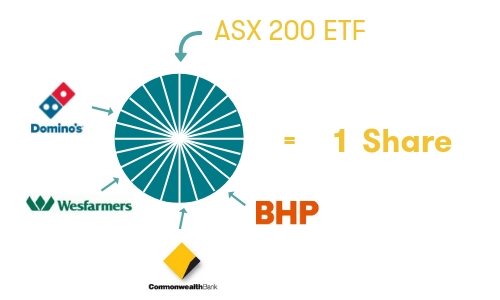What is an Exchange Traded Fund (ETF)?

The popularity of ETFs has grown substantially in the last few years. In fact, as of June 30, 2022 there were 252 ETF products available in the Australian market, totally $121.45 billion of funds under management.
With increasing talk about this relative newcomer on the investment scene, it might be time to get more acquainted with exchange traded funds.
How do ETFs work?
Exchange-traded funds (ETFs) are a security that typically tracks a stock index or sector. You can also get ETFs that track a commodity, bond or a range of assets. ETFs are traded on the stock market, when you buy an ETF you are buying shares of a portfolio that tracks the yield and return of its corresponding index or asset.
For example, when you buy into an ETF that tracks the ASX 200, you are in effect purchasing a little bit of each of the top 200 companies traded on the Australian Securities Exchange – see the example below.

An ETF which tracks a sector index, let’s take energy for example, would result in you effectively holding a small part of each of the energy-related companies on the ASX.
Related Article: Who offers ETFs in Australia?
Active vs Passive ETFs
As their name would imply, active ETFs are just that: actively managed. A fund manager or team oversee the ETF. Actively managed ETFs offer similar benefits in terms of liquidity and tax efficiency to passive ETFs and have a benchmark index, but the managers of these funds may deviate from the index in response to market changes or where they see fit. Essentially, the portfolio construction is at the discretion of the fund manager.
Though it is their goal, it’s important to remember there is no guarantee an Active ETF will outperform a passive equivalent.
As active managers have the freedom to trade outside the index, shareholders may not always know their portfolio construction. ASIC’s regulatory measures aim to protect traders and investors alike.
View all Canstar rated Online Share Trading products. View Disclosures.
What’s the difference between ETFs and Index funds?
ETFs and index funds have a lot in common, both are popular forms of passive investing and are pooled investments vehicles. However, the key difference is that ETFs can be bought and sold on an exchange, like the ASX. Index funds are available to purchase directly through the associated fund provider, like Vanguard or Blackrock.
It’s a mixed bag
Initially, ETFs were seen solely as passive investment option as traditionally it only tracked stock market indexes and didn’t have a fund manager to actively manage the investment.
However, in the last few years this has changed. ETFs today can come in many different forms. As mentioned above, ETFs that track commodities, bonds and a basket of other assets are now available. You could, for example, buy an ETF that tracks the investment results of global equities in the healthcare sector. Those interested in ethical investing, may be interested in ETFs that just track the performance of companies that are leaders in climate change.
Some ETFs available now are actively managed – although only a small percentage. Meaning, that they have a fund manager to oversee the investment and who actively tries to beat the market, therefore increasing investors’ returns.
Related article: Active vs. Passive Investing – What’s the difference?
Why invest in an ETF?
There are a number of benefits ETFs can provide to investors, such as:
Diversification – ETFs can provide investors exposure to a number of different asset classes, countries and sectors all in a single trade.
Lower management fees – The management fee for ETFs tend to be lower when compared to Managed Funds, and unlike managed funds, most ETFs do not charge a performance fee.
Liquidity – Because ETFs are traded on the stock market this allows investors to trade ETFs stocks with relative ease, making it a highly liquid asset.
Pricing – ETFs trade very closely to their net asset value. Because ETFs are traded on the stock market investors are able to see the price and value of their investment.
Risks
ETFs also have a number of risks to be aware of. These include market risk, liquidity risk and currency risk (particularly if you’ve invested in an international or global ETF). Check out this article on common investment risks to learn more.
ETFs do not suit every investor, so before investing be sure to read the PDS, and if ever in doubt seek the help of a professional financial adviser.
How to invest in ETFs
As ETFs are traded on the stock market, in order to invest in them you will need a broker or an online share trading platform. Alternatively, if you don’t have a lump sum to invest, many micro-investing apps also invest in ETFs.
This article was reviewed by our Content Producer Isabella Shoard before it was updated, as part of our fact-checking process.
Try our Investor Hub comparison tool to instantly compare Canstar expert rated options.







